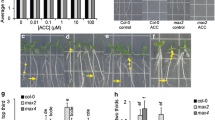Abstract
We have examined the inward-rolling and outward-opening of petals from 90° stage carnation flowers (Dianthus charyophyllus L. cv. Pink Donor). Ethylene released from 2-chloroethylphosphonic acid (CEPA) induced in-rolling in the lower portions of the petals while that action was suppressed by an inhibitor of auxin transport. Another plant hormone, indole-3-acetic acid (IAA), intensified this ethylene-induced in-rolling. In contrast, when ethylene was not applied, the same IAA concentration promoted the opening of petal segments. Our data suggest that a low level of ethylene acts on IAA-induced opening. Likewise, we can speculate that endogenous concentrations of ethylene could be an important determinant of petal responses that involve interactions between ethylene and IAA.
Similar content being viewed by others
Literature Cited
Abeles FB, Morgan PW, Saltveit ME Jr (1992) Ethylene in Plant Biology, Ed 2. Academic Press, San Diego
Baskin TI, Beemster GTS, Judy-March JE, Marga F (2004) Disorganization of cortical microtubules stimulates tangential expansion and reduces the uniformity of cellulose microfibril alignment among cells in the root ofArabidopsis. Plant Physiol135: 2279–2290
Benjamins R, Malenica N, Luschnig C (2005) Regulating the regulator: The control of auxin transport. Bioessays27: 1246–1255
Fisher DD, Cyr RJ (1998) Extending the microtubule/microfibril paradigm. Plant Physiol116: 1043–1051
Friml J, Wisniewaka J, Benkova E, Mendgen K, Palme K (2002) Lateral relocation of auxin efflux regulator PIN3 mediates tropism inArabidopsis. Nature415: 806–809
In BC (2001) Effect of 1-methylcyclopropane (1-MCP) on the Retardation of Senescence in Cut Flowers of Hibiscus and Carnation. M.S. thesis, KonkukUniversity, Seoul
Ishiki Y, Oda A, Yaegashi Y, Orihara Y, Arai T, Hirabayashi T, Nakagawa H, Sato K (2000) Cloning of an auxin-responsive1-aminocyclopropane-1-carboxylate synthase gene (GMe-ACS2) from melon and the expression ofACS genes in etiolated melon seedlings and melon fruits. Plant Sci159: 173–181
Kim ES, Son KC, Lee SH, Oh SE (1998) The in-rolling phenomena of petals during senescence in cut carnation (Dianthus caryophyllus L. cv. Shinkibo). J Plant Biol41: 304–311
Lehman A, Black R, Ecker JR (1996)HOOKLESS1, an ethylene response gene, is required for differential cell elongation in theArabidopsis hypocotyls. Cell85: 183–194
Mor Y, Halevy AH, Spiegelstein H, Mayak S (1985) The site of 1aminocyclopropane-1-carboxylic acid synthesis in senescing carnation petals. Physiol Plant65: 196–202
Nam KH, Song YJ, Joo JH, Ryu HY, Lee JS, Bae YS (2007) Reactive oxygen species mediate IAA-induced ethylene production in mungbean (Vigna radiata L.) hypocotyls. J Plant Biol50: 18–23
Oono Y, Ooura C, Rahman A, Aspuria ET, Hayashi K, Tanaka A, Uchimia H (2003)p-Chlorophenoxyisobutyric acid impairs auxin response inArabidopsis root. Plant Physiol133: 1135–1147
Plieth C, Trewavas AJ (2002) Reorientation of seedlings in the Earth0’s gravitational field induces cytosolic calcium transients. Plant Physiol129: 786–796
Poupart J, Rashote AM, Muday GK, Waddell CS (2005) The rib1 mutant ofArabidopsis has alterations in indole-3-butyric acid transport, hypocotyls elongation, and root architecture. Plant Physiol139: 1460–1471
Rahman A, Satoko Hosokawa S, Oono Y, Amakawa T, Goto N, Tsurumi S (2002) Auxin and ethylene response interactions duringArabidopsis root hair development dissected by auxin influx modulators. Plant Physiol130: 1908–1917
Strydom GJ, Whitehead CS (1990) The effect of ionizing radiation on ethylene sensitivity and post-harvest ripening of banana fruit. Sci Hortic41: 293–304
Taguchi G, Yoshizwa K, Kodaira R, Hayashida N, Okazaki M (2001) Plant hormone regulation on scopoletin metabolism from culture medium into tobacco cells. Plant Sci160: 905–911
Taiz L (1984) Plant cell expansion: Regulation of cell wall mechanical properties. Annu Rev Plant Physiol35: 585–657
Takahashi H, Kawahara A, Inoue Y (2003) Ethylene promotes the induction by auxin of the cortical microtubule randomization required for low-pH-induced root hair initiation in lettuce (Lactuca sativa L.) seedlings. Plant Cell Physiol44: 932–940
Terasaka K, Blakeslee JJ, Titapiwatanakun B, Peer WA, Bandyopadhyay A, Makam SN, Lee OR, Richards EL, Murphy AS, Sato F (2005) PGP4, an ATP binding cassette P-glycoprotein, catalyzes auxin transport inArabidopsis thaliana roots. Plant Cell17:2922–2939
Ursin VM, Bradford KJ (1989) Auxin and ethylene regulation of petiole epinasty in two developmental mutants of tomato,diageotropica andepinastic. Plant Physiol90: 1341–1346
Vandenbussche F, Vriezen WH, Smalle J, Laarhoven LJJ, Harren FJM, van der Straeten D (2003) Ethylene and auxin control theArabidopsis response to decreased light intensity. Plant Physiol133: 517–527
Whitehead CS, Vasiljevic D (1993) Role of short chain saturated fatty acid in the control of ethylene sensitivity in senescing carnation flowers. Physiol Plant88: 243–250
Yang Y, Hammes UZ, Taylor CG, Schachtman DP, Nielsen E (2006) High-affinity auxin transport by the AUX 1 influx carrier protein. Curr Biol16: 1123–1127
Yuan M, Shaw PJ, Warn RM, Lloyd CW (1994) Dynamic reorientation of cortical microtubules from transverse to longitudinal in living plant cells. Proc Natl Acad Sci USA91: 6050–6053
Zhang XS, O'Neill SD (1993) Ovary and gametophyte development are coordinately regulated by auxin and ethylene following pollination. Plant Cell5: 403–418
Author information
Authors and Affiliations
Corresponding author
Rights and permissions
About this article
Cite this article
Doh, E.J., An, W.G., Son, KC. et al. Ethylene and indole-3-Acetic Acid participate in the in-rolling and opening of carnation petal segments. J. Plant Biol. 50, 174–180 (2007). https://doi.org/10.1007/BF03030627
Received:
Accepted:
Issue Date:
DOI: https://doi.org/10.1007/BF03030627



